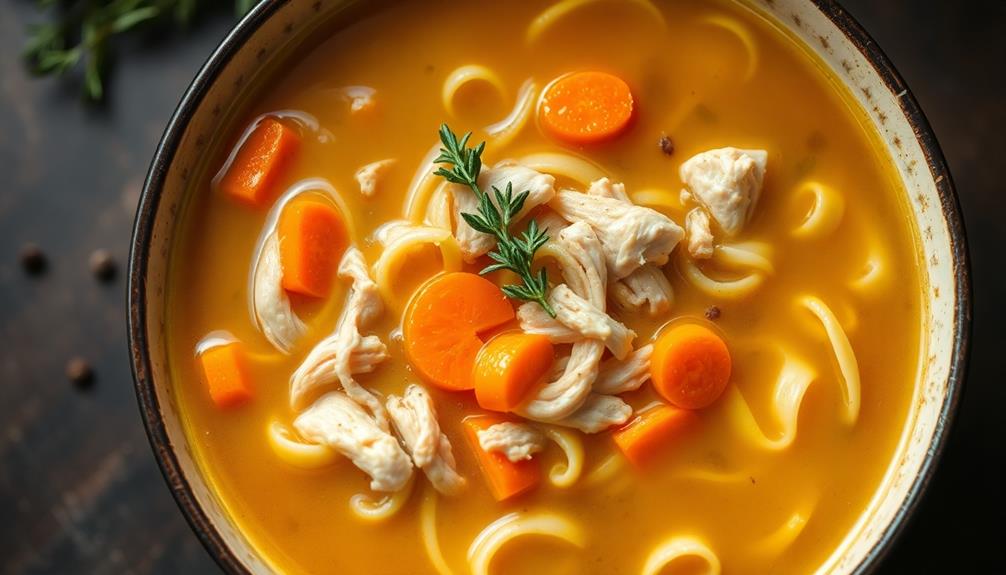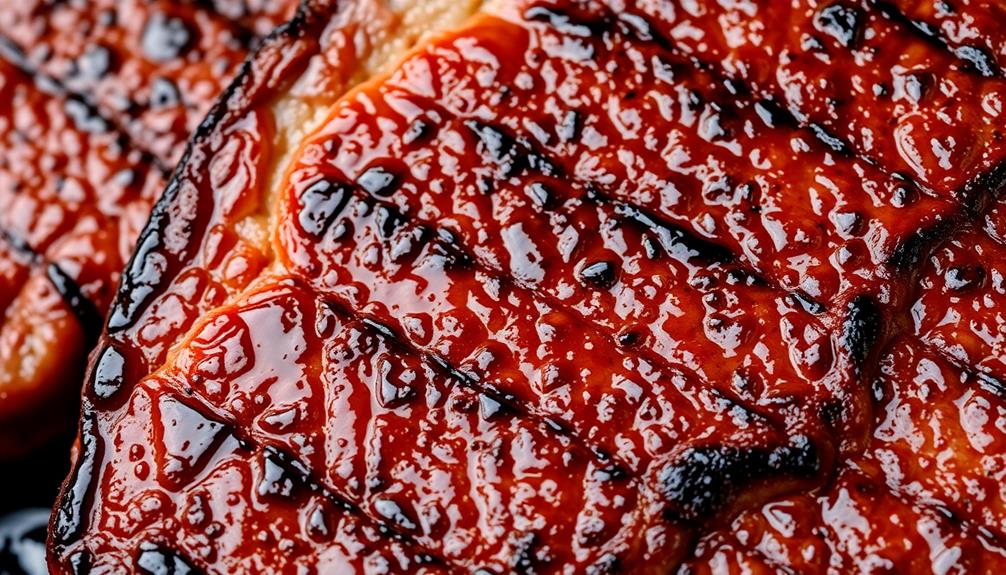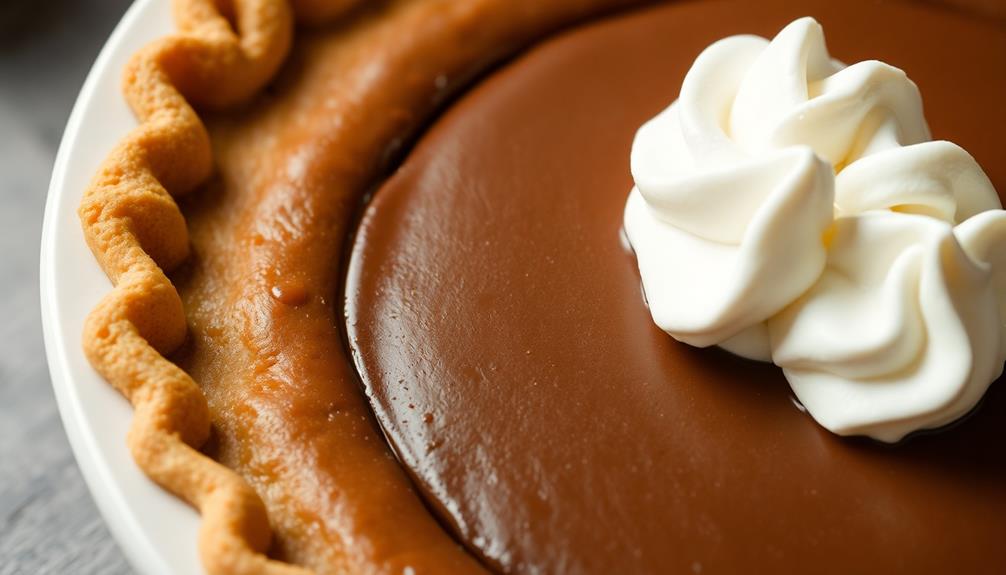Chicken noodle soup is a comforting classic that's sure to warm your soul! Its roots trace back to ancient Greece and Rome, where people prized chicken broth for its restorative powers. As the dish spread across Europe, it evolved to reflect local flavors and traditions. When immigrants brought their recipes to the United States, they added even more diversity to this beloved staple. Today, it remains a cherished comfort food, evoking nostalgic memories of home. Want to learn how to make this soothing soup from scratch? Just keep reading!
Key Takeaways
- Chicken noodle soup has a rich history, tracing its origins to ancient Greece and Rome, where chicken broth was valued for its restorative properties.
- The dish has evolved over time, reflecting local flavors and culinary traditions as it spread across Europe and the United States.
- Crafting chicken noodle soup from scratch allows for personal touches, with diverse recipes contributed by immigrants enhancing the classic dish.
- The cooking process involves chopping vegetables, simmering the broth, and incorporating noodles and cooked chicken to create a comforting and nourishing meal.
- Chicken noodle soup remains a cherished comfort food, evoking nostalgic memories and fostering connection, conversation, and comfort when shared.
History
Tracing the origins of chicken noodle soup, you'll find that this comforting dish has roots dating back centuries. Its simple yet nourishing ingredients have long been treasured for their ability to soothe the body and soul.
The earliest versions of chicken noodle soup can be traced to ancient Greece and Rome, where chicken broth was prized for its restorative properties. As the dish spread through Europe, local variations emerged, each reflecting the unique flavors and culinary traditions of the region.
In the United States, chicken noodle soup became a beloved staple, especially during the colder months. Its popularity grew as immigrants from around the world shared their own takes on the classic recipe.
Today, chicken noodle soup remains a cherished comfort food, offering a warm and familiar taste that transports us back to childhood memories of home.
Cooking Steps
To begin the cooking process, gather all the necessary ingredients and equipment.
You'll need a large pot, a sharp knife, a cutting board, and measuring cups and spoons. For the soup, you'll need chicken, carrots, celery, onions, egg noodles, chicken broth, and a few simple seasonings.
Start by cutting the chicken into bite-sized pieces. Next, dice the carrots, celery, and onions.
In the large pot, sauté the vegetables in a bit of oil until they're tender. Then, add the chicken and chicken broth, bringing the mixture to a boil.
Once it's boiling, reduce the heat and let the soup simmer for about 15 minutes.
Step 1. Chop Onions, Carrots, and Celery
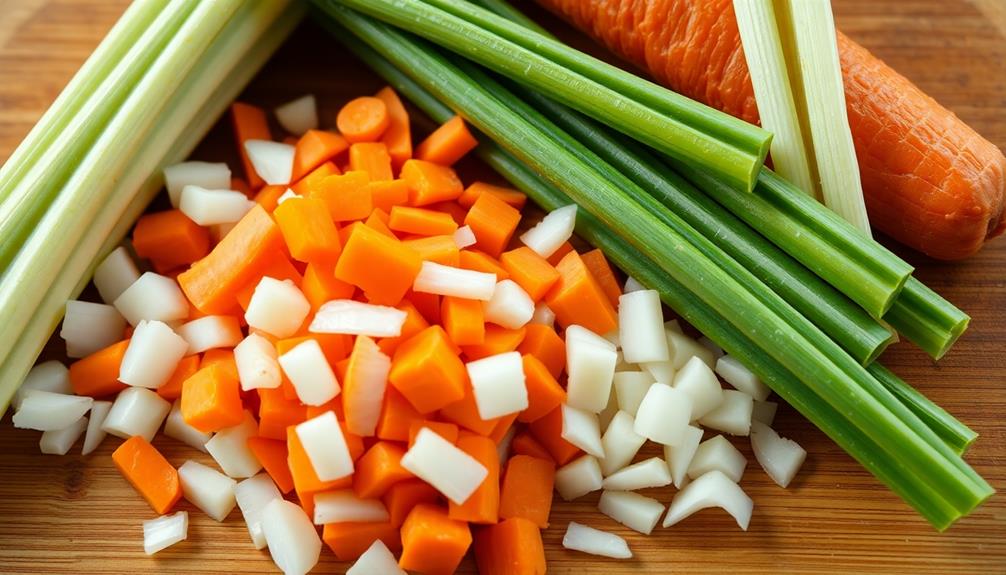
Next, let's tackle the onions, carrots, and celery. First, grab your cutting board and a sharp knife. You'll need to dice the onions, carrots, and celery into small, even pieces.
Start with the onions – peel them, then slice them in half from root to stem. Lay the halves flat and make thin, parallel cuts across the onions, then turn the board and chop perpendicular to create a nice dice.
For the carrots, peel them and slice them into thin rounds. Then, stack the rounds and slice them into matchsticks, and finally, dice them.
As for the celery, wash the stalks, then slice them lengthwise into thin strips. Gather the strips and make perpendicular cuts to dice the celery.
Once you've prepared all the veggies, you're ready to sauté them in the pot and build the flavor of your delicious chicken noodle soup!
Step 2. Add Stock

After sautéing the vegetables, pour in the chicken stock. This is where the magic really starts to happen! The rich, savory broth is the foundation of your delicious soup. Carefully pour in the stock, making sure to scrape up any browned bits from the bottom of the pot. These bits are packed with flavor and will infuse your soup with even more deliciousness.
Once the stock is in, give it a good stir. Let the mixture come to a gentle simmer, then reduce the heat to low.
Now, let the soup simmer for about 15 minutes, allowing the flavors to meld together. The longer it simmers, the more the vegetables will soften and the broth will thicken. Be sure to taste it along the way and adjust the seasoning as needed. Add a pinch of salt and pepper to really make those flavors pop.
Step 3. Add Noodles and Chicken
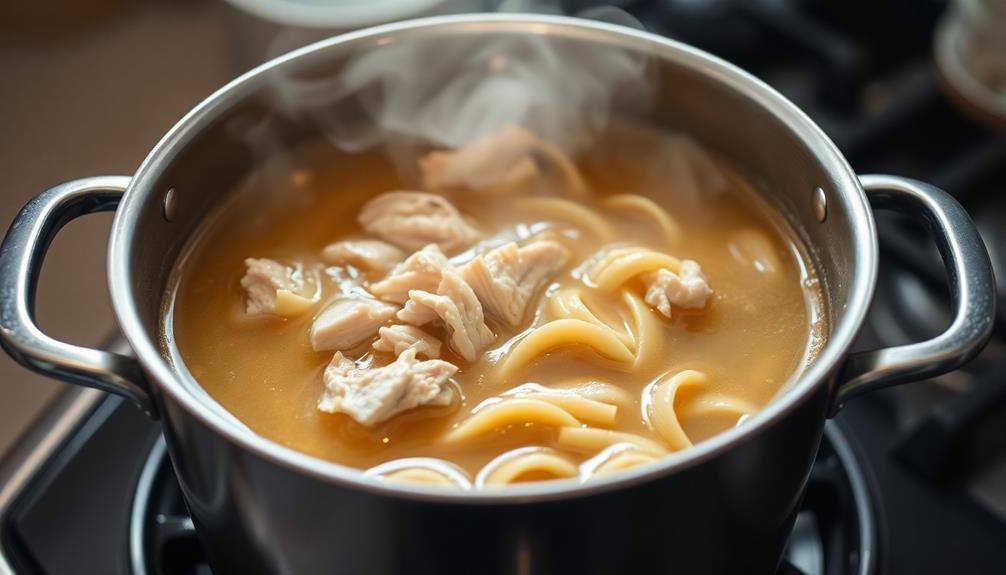
With the broth simmering, it's time to add the noodles and chicken. Grab your favorite dried egg noodles and gently drop them into the hot broth.
Stir occasionally as the noodles soften and cook through, about 8-10 minutes.
Next, add your shredded or diced cooked chicken. This can be leftover rotisserie chicken or chicken you've cooked specifically for the soup.
Stir the chicken into the broth and let it warm through, just 2-3 minutes. The noodles should be tender and the chicken heated by this point.
Now you can adjust the seasoning if needed. Add a pinch more salt and pepper, or perhaps a sprinkle of dried herbs like thyme or parsley.
Taste and tweak until the flavors are just right. Your comforting chicken noodle soup is almost ready to enjoy!
Ladle it up into bowls and get ready for a satisfying, soul-warming meal.
Step 4. Simmer for 15-20 Minutes

Once the noodles and chicken have been added, let the soup simmer for 15-20 minutes. This is a crucial step that allows the flavors to meld and the ingredients to fully cook through.
As the soup simmers, you'll start to notice the aroma of the herbs and spices filling your kitchen. The chicken will become tender and juicy, and the noodles will soak up all the delicious broth.
Be sure to keep an eye on the pot, stirring occasionally to prevent anything from sticking to the bottom. You'll know it's ready when the noodles are cooked through and the chicken is no longer pink.
The soup should have a nice, rich consistency that's perfect for warming you up on a chilly day. Once the timer goes off, your homemade chicken noodle soup is ready to serve! Ladle it into bowls and enjoy the comforting flavors. Get ready for your taste buds to be delighted.
Step 5. Taste and Adjust Seasonings

Taste is the ultimate judge as you assess the soup's flavor profile. Gently dip in a clean spoon and give the broth a sip. How does it taste? Is it well-seasoned, or does it need a little something extra? Don't be afraid to adjust the seasonings to suit your preferences.
Start by adding a pinch of salt and a grind or two of black pepper. Stir the soup and taste again. If it still needs more seasoning, try a splash of soy sauce for a savory umami boost or a squeeze of lemon juice for brightness. A sprinkle of dried herbs, like thyme or parsley, can also enhance the overall flavor.
Keep tasting and adjusting until the soup is perfectly balanced – not too salty, not too bland, but just right. This is your chance to make the dish your own and ensure every bite is as delicious as can be.
Trust your taste buds and have fun experimenting!
Final Thoughts
The chicken noodle soup you've prepared is a comforting and nourishing dish that can warm the soul on a chilly day. You can take pride in crafting this classic recipe from scratch, infusing it with your own personal touch.
The aromatic blend of herbs and spices, the tender chicken, and the chewy noodles come together in perfect harmony, creating a bowl of pure culinary bliss.
As you savor the last spoonful, you'll feel a sense of accomplishment and satisfaction. This soup is more than just a meal – it's a testament to your culinary skills and your ability to nurture and nourish those around you. As you wipe the last remnants of the rich and creamy clam chowder from your lips, you’ll know that you’ve provided a warm and comforting experience for yourself and others. The taste of the savory broth and tender clams lingers, leaving a lasting imprint of your talent in the kitchen. This soup embodies the love and care you put into each dish, making it more than just a meal, but a memorable experience for all who enjoy it.
When shared with family and friends, it becomes a vessel for connection, conversation, and comfort.
Frequently Asked Questions
What Are the Health Benefits of Chicken Noodle Soup?
Chicken noodle soup is a powerhouse of goodness!
It's loaded with vitamins, minerals, and nutrients that can help keep you healthy. The broth contains protein to build strong muscles, while the veggies provide fiber to keep your tummy happy.
Plus, the warm, comforting soup can soothe a sore throat and boost your immune system.
Can I Make Chicken Noodle Soup in a Slow Cooker?
Yes, you can absolutely make delicious chicken noodle soup in a slow cooker!
The slow cooking process allows the flavors to meld together perfectly, making the broth extra rich and comforting. Just toss in the chicken, veggies, noodles, and seasonings, then let your slow cooker work its magic.
In a few hours, you'll have a hearty, homemade soup that's perfect for a chilly day. The slow cooker makes it so easy – you'll wonder why you didn't try it sooner!
How Do I Store Leftover Chicken Noodle Soup?
Storing leftover soup is a breeze! First, let it cool to room temperature.
Then, pour the soup into airtight containers or freezer-safe bags. Seal them up tight to keep out air, which can make the soup go bad.
Pop the containers in the fridge for up to 4 days or the freezer for up to 3 months.
When you're ready to enjoy it again, just reheat on the stovetop or in the microwave. Easy peasy! Your delicious soup will be as good as new.
Can I Freeze Chicken Noodle Soup for Later Use?
Yes, you can absolutely freeze chicken noodle soup for later use!
Freezing is a great way to save any leftover soup and enjoy it another day. Just let the soup cool completely, then pour it into airtight containers or freezer bags.
When you're ready to reheat, simply thaw it in the fridge overnight and warm it up on the stove or in the microwave.
Frozen chicken noodle soup will keep for up to 3 months, so you can savor that comforting flavor anytime!
What Are Some Variations of Chicken Noodle Soup?
There are lots of delightful variations of chicken noodle soup you can try!
One popular twist is to add different noodle shapes like orzo or egg noodles. You could also mix in vegetables like carrots, celery, or peas for extra flavor and nutrition.
Some people like to spice it up with herbs and seasonings like thyme, bay leaves, or a dash of hot sauce.
The possibilities are endless – get creative and make it your own!
